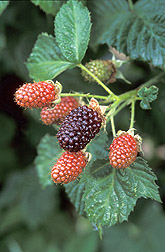This page has been archived and is being provided for reference purposes only. The page is no longer being updated, and therefore, links on the page may be invalid.
|
Read the magazine story to find out more. |
|
|
|
|
A "Berry" Good Bee for Pollinating Blackberries and Raspberries
By Marcia WoodFebruary 7, 2008
Bringing grains of pollen to waiting blackberry and red raspberry blossoms may be the special talent of a small, emerald-green bee called Osmia aglaia. That's according to Agricultural Research Service (ARS) entomologist James H. Cane, who—in outdoor experiments in Oregon and Utah—has studied the pollination prowess of this 3/8-inch-long bee perhaps more extensively than any other scientist.
The hardworking bee, native to Oregon and California, may help with pollination chores, augmenting the work of America's best-known crop pollinator, the European honey bee Apis mellifera. In recent years, hived honey bees across the country have been hit hard by a mostly mysterious condition known as colony collapse disorder. That problem—and others caused by mites, beetles, diseases and Africanized honey bees—have added even more urgency to the need to find proficient pollinators among America's wild native bees, noted Cane.
He's based at the ARS Pollinating Insect Biology, Management and Systematics Research Unit in Logan, Utah. In one series of experiments, Cane showed that O. aglaia bees work quickly, visiting just as many red raspberry flowers, and nearly as many blackberry blossoms, as do honey bees, in the same amount of time.
Both kinds of berries are mostly self-pollinating, meaning that they can form fruit without the need for insects to bring pollen to them. But better berries result if honey bees or O. aglaia visit red raspberry flowers, Cane found. The plump, well-formed fruits were 30 percent bigger than those on red raspberry plants not visited by either bee species.
Read more about this research in the February 2008 issue of Agricultural Research magazine.
ARS is the U.S. Department of Agriculture's chief scientific research agency.

